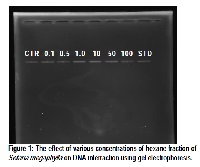Immunomodulatory, cytotoxic and antileishmanial activity of Setaria megaphylla
Keywords:
Setaria megaphylla, Cytotoxic, antioxidative burst, antileishmanialAbstract
Cytotoxic, antioxidative burst and antileishmanial properties of leaf extract and fractions of Setaria megaphylla were investigated to ascertain the folkloric claims of its potency in inflammatory diseases and infections. The leaf extract and fractions of Setaria megaphylla were investigated for anticancer activity against HeLa cells using SRB method and DNA interaction activity using gel electrophoresis. Antioxidative burst activity of the extract in whole blood, neutrophils and macrophages was also investigated using luminol/lucigenin-based chemiluminescence assay. The extract and fractions were similarly screened for antileishmanial activity against promastigotes of Leishmania major in vitro. The GCMS analysis of the most active fraction against HeLa cells was carried out. The leaf extract was found to exert significant anticancer activity with the hexane fraction exhibiting the most pronounced effect. The crude extract and the fractions did not interact with DNA when investigated using electrophoresis. The extract prominently inhibited oxidative burst activity in whole blood, isolated polymorphonuclear cells (PMNs) and mononuclear cells (MNCs) when two different phagocytosis activators (serum opsonizing zymosan-A and PMA) were used. The extract also exhibited moderate antileishmanial activity against promastigotes of Leishmania major in vitro. GCMS analysis of active fraction revealed pharmacologically active compounds. These results suggest that the leaf extract/fractions of S. megaphylla possesses cytotoxic, antioxidative burst and antileishmanial activities and these justify its use in ethnomedicine to treat inflammatory diseases and microbial infections and can be exploited in primary healthcare.
References
. Van Oudtshoorn, F. P. Guide to
Grasses of South Africa. Briza
Publications, Cape Town. 1999
. Lowe, J. The Flora of Nigeria Grasses
(2nd Edition) Ibadan University Press.
Ibadan, Nigeria. 1989
. C. Clarkson, V. J. Maharay, N. R.
Crouch, O. M. Grace, P. Pillay, M. G.
Matsabisa, N. Bhagwandin, P. J.
Smith, P. I. Folb. In vitro
antiplasmodial activity of Medicinal
Plants native to or naturalized in
South Africa. J. Ethnopharm. 2004;92
(2-3):177-191.
. Okokon JE,Ubulom PM, Udokpoh AE.
Antiplasmodial activity of Setaria
megaphylla .Phytotherapy Research.
;21(1): 366 – 368.
. Okokon JE,Antia BS. Hypoglycaemic
and Antidiabetic effect of Setaria
megaphylla on normal and alloxan
induced diabetic Rats. Journal of
Natural Remedy. 2007;1(4):134 –
. Okokon JE, Bassey AL,Nwidu LL.
Antidiabetic and hypolipidaemic
activity of ethanolic root extract of
Setaria megaphylla. International
Journal of Pharmacology.
;3(1):91 – 95.
. Okokon JE,Antia BS, Ita BN.
Antiiflammatory and antinociceptive
effects of ethanolic extract of Setaria
megaphylla leaves in rodents. African
Journal of Biomedical Research.
; 9( 1):229 – 233.
. Helfand S, Werkmeister J, Roder J.
Chemiluminescence response of
human natural killer cells. I. The
relationship between target cell
binding, chemiluminescence, and
cytolysis. The Journal of Experimental
Medicine 1982;156(3): 492 – 505.
. Haklar G, Ozveri ES, Yuksel M, Aktan
A, Yalcin AS. Different kinds of
reactive oxygen and nitrogen species
were detected in colon and breast
tumors. Cancer Letters 2001;165: 219
-224.
. P. Houghton R, Fang I,
Techatanawat Steventon G, Hylands
PJ, Lee CC. The sulphorhodamine
(SRB) assay and other approaches to
testing plant extracts and derived
compounds for activities related to
reputed anticancer activity. Methods
; 42:377-387.
. Tian B, Hua Y. Concentration
dependence of prooxidant and
antioxidant effects of aloin and aloeemodin on DNA. Food Chem. 2005;
: 413 – 418.
. Atta-ur-Rahman, M. I. Choudhary, J.
T. William. Bioassay techniques for
drug development. Harward Academic
Publisher, 1997. pp 67- 68.
. Adams RP. Identification of Essential
oils by Gas Chromatography
Quadrupole Mass Spectrometry.
Allured Publishing Corporation, Carol
Stream, USA. 2001
. Setzer WN, Stokes SL, Penton AF.
Cruzain Inhibitory Activity of Leaf
Essential Oils of Neotropical
Lauraceae and Essential Oil
Components. Natural Product
Communications 2007;2(12): 1203 –
. Tan PG, Zhong WJ, Cai WQ.
Continuously infused chemotherapy in
treatment of malignant brain tumors.
Zhongguo Zhongliu Linchuang
;28: 682 – 684.
. Sarumathy K,Dhana Rajan MS, Vijay
T, Jayakanthi J. Evaluation of
phytoconstituents, nephro-protective
and antioxidant activities of Clitoria
ternatea. Journal of Applied
Pharmaceutical Science 2011; 1(5):
-172.
. Kumar PP, Kumaravel S, Lalitha C.
Screening of antioxidant activity, total
phenolics and GC-MS study of Vitex
negundo. African Journal of
Biochemical Research 2010;4(7):191-
. Simopoulos AP. Omega-3-fatty acids
in health and disease and in growth
and development. Am. J. Clin. Nutr
;54: 438 – 463.
. Simopoulos AP ω-3-fatty acids in the
prevention management of
cardiovascular disease. Can. J.
Physiolo. Pharmacol. 1997;75:234 –
. Simopoulos AP. Omega -3-fatty acids
and anti-oxidants in edible wild plants.
Boil. Res. 2004; 37:263-277.
. Aderogba MA, McGaw L. J, Bezabih
M, Abegaz BM. Isolation and
characterisation of novel antioxidant
constituents of Croton zambesicus
leaf extract. Natural Product Research
;25(13):1224 -1233
. Halliwell B, Gutteridge JM. Free
Radicals in Biology andMedicine, 3rd
ed. Oxford: Oxford University
Press.1999.
. Anderson R, Gatner EMS, van
Rensburg CE, Grabow G, Imkamp
FH, Kok SK, van Rensburg J. In vitro
and In vivo effect of dapsone on
neutrophils and lymphocyte functions
in normal individuals and patients with
lepromatous leprosy. Antimicrobial
Agents and Chemotherapy.1981;19:
– 503.
. Habtemariam S, Gray AI, Waterman
PG. A new antibacterial
sesquiterpenes from Premna
aligotricha. Journal Natural Products
;56: 3864 – 74



